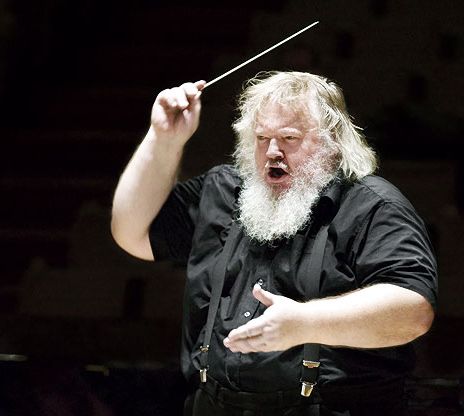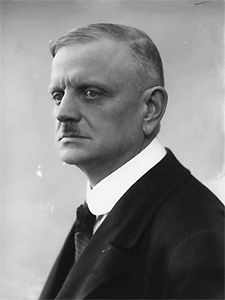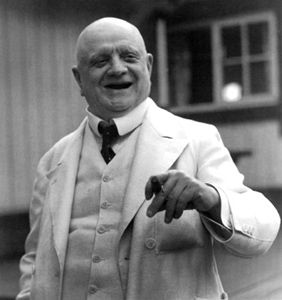wimpel69
11-03-2012, 01:40 AM
As requested in my classical program music thread: These are the seven symphonies composed by Jean Sibelius in
fine, characterful performances under Leif Segerstam, conducting the Helsinki Philharmonic Orchestra.
Enjoy!

Music Composed by Jean Sibelius
Played by the Helsinki Philharmonic Orchestra
With Pekka Kuusisto (violin)
And the Polytech Male Choir of Helsinki (Finlandia)
Conducted by Leif Segerstam
"These four discs collect Leif Segerstam's second cycle of the symphonies of Sibelius. First issued by Ondine in
the early years of the 21st century as separate discs filled out with symphonic poems, the symphonies are here
condensed into a cold, hard block of eternity. Segerstam's first Sibelius cycle for Chandos in the early Nineties aimed
both barrels at eternity, but with the Danish Radio Symphony Orchestra's colorful and dedicated but sometimes too
cheerful playing, he didn't always hit it. But back home in Finland with the even more dedicated but more darkly colored
and wholly idiomatic playing of the Helsinki Philharmonic Orchestra, Segerstam nails eternity every time. The Helsinki
musicians have Sibelius' music in their blood, and their playing is strong, sure and absolutely authentic, while Segerstam,
a composer as well as a conductor, creates as much as re-creates the scores in his interpretations. In their heroic First's
tragic Finale, in their dramatic Second's harrowing Tempo andante, ma rubato, in their bucolic Third's crepuscular Andantino
con moto, quasi allegretto, in the radiant Fifth's turn to the minor before the Allegro molto's final peroration, in the
pastoral Sixth's despairing Allegro molto, in the enigmatic Seventh's roaring developments and especially in all of the
baleful Fourth's aggressive nihilism, Segerstam and the Helsinki express the sense of eternity which is at the heart of
Sibelius' symphonic art. The couplings of Finlandia performed with the fervent and muscular Polytech Male Choir of
Helsinki and of the Violin Concerto performed with the passionate and robust Pekka Kuusisto are fine additions to the set,
but it is Segerstam and the Helsinki's symphonies which will keep Sibelius' devotees coming back."
James Leonard, All Music

"The recent outpouring of Sibelius Third symphonies has shed remarkable light on this seemingly reticent
work, from Mustonen’s radically neoclassical rendition (also on Ondine) to Davis’ recent, very Romantic
and “hands on” approach (LSO Live). Fine as those versions are, I have to say that in the final analysis
Leif Segerstam has them all beat. Indeed, there are no finer performances available of either symphony,
and that’s saying a lot–but once you hear this exceptional disc I have little doubt that you will agree.
This disc is special.
In the Third Symphony Segerstam finds exactly the right tempo for each movement: a real allegro moderato
to start, an andantino con moto (quasi allegretto) in the very difficult-to-judge middle, and a flowing moderato–allegro
(ma non tanto) finale. The key here is to balance the composer’s “moderate” injunction with the need to
differentiate both tempos and character. Segerstam does just that. His first movement has great thrust and
rhythmic snap: note particularly the punchy recapitulation of the second subject, with spiky wind ostinatos and
extremely clean timpani. He also doesn’t drag the central movement out to the lengths that V�nsk� does, but
rather allows us to register the tension created by the games Sibelius plays with phrasing and rhythms of two-
versus-three beats to the bar.
The finale has more mystery and lightness in its initial stages than any other version, and when the big tune
arrives Segerstam leaves plenty of room to build the closing pages without having to stop the movement
dead in its tracks. He’s also obviously given much thought to the problematic endings of both outer movements,
and he gives them plenty of time to bring the music to a satisfying halt, even if this means taking additional
freedom with the basic tempo. Throughout, the playing of the orchestra is simply gorgeous, with extremely
characterful string phrasing, cutting but always well-tuned interjections from the winds, and imposing but
never crude brass and timpani. Ensemble balances are simply perfect between sections, and the sonics
are warmly natural.
All of these virtues likewise characterize the Fifth Symphony, which receives easily the most satisfying performance
of the finale on disc. In the first movement Segerstam executes a seamless transition between its two big halves,
wisely refusing to speed up too soon, and he achieves a brilliantly energetic coda. The central andante, so similar
in character (it now seems) to that of the Third Symphony, has more musical muscle than usual without ever
turning heavy or dragging, again a function of rhythmic control and textural clarity. And then there’s that finale!
The initial pages churn with energy and the grand tune soars aloft on an effortlessly heroic brass ostinato.
But the real thrill comes in the final few minutes, which are more powerfully and intelligently built than in any
other performance. One huge wave of music follows another until Segerstam releases the tension with a jolt
of forward movement that offers a positively physical impact, and not incidentally makes sense of those
strange final chords (played a touch more quickly than usual, I might add).
We should expect that this orchestra would know this music better than most, and that the players can toss
off these works in their collective sleep if they so choose. That’s why it’s all the more special that familiarity
has not bred contempt, and that they offer these two symphonies to us as if discovering the music for the
first time in terms of spontaneity and freshness, even as the technical standards bespeak long familiarity.
To Segerstam must go the credit for finding interpretive points that are unique to his own view of the music
and that also clearly serve the composer’s intentions, never sounding unidiomatic or self-indulgent. There are
many first-rate recordings of these symphonies, the Fifth especially, but if I had to dump all of those others I
could very easily live with this one and be fully satisfied. It’s that good."
Classics Today (Symphonies 3 & 5) http://i1084.photobucket.com/albums/j415/wimpel69/p10s10-1.gif



Source: Ondine Set (4 CDs) - my rip!
Format: mp3, 320k/s (CBR), DDD Stereo
File Size: 640 MB
Download Link (re-up) - https://mega.co.nz/#!tExmQDhR!TVe94XrLrS8q1vWjcZqLyA1XnboyAWmYQhaObDf kqcc
Enjoy! Don't share! :)
fine, characterful performances under Leif Segerstam, conducting the Helsinki Philharmonic Orchestra.
Enjoy!

Music Composed by Jean Sibelius
Played by the Helsinki Philharmonic Orchestra
With Pekka Kuusisto (violin)
And the Polytech Male Choir of Helsinki (Finlandia)
Conducted by Leif Segerstam
"These four discs collect Leif Segerstam's second cycle of the symphonies of Sibelius. First issued by Ondine in
the early years of the 21st century as separate discs filled out with symphonic poems, the symphonies are here
condensed into a cold, hard block of eternity. Segerstam's first Sibelius cycle for Chandos in the early Nineties aimed
both barrels at eternity, but with the Danish Radio Symphony Orchestra's colorful and dedicated but sometimes too
cheerful playing, he didn't always hit it. But back home in Finland with the even more dedicated but more darkly colored
and wholly idiomatic playing of the Helsinki Philharmonic Orchestra, Segerstam nails eternity every time. The Helsinki
musicians have Sibelius' music in their blood, and their playing is strong, sure and absolutely authentic, while Segerstam,
a composer as well as a conductor, creates as much as re-creates the scores in his interpretations. In their heroic First's
tragic Finale, in their dramatic Second's harrowing Tempo andante, ma rubato, in their bucolic Third's crepuscular Andantino
con moto, quasi allegretto, in the radiant Fifth's turn to the minor before the Allegro molto's final peroration, in the
pastoral Sixth's despairing Allegro molto, in the enigmatic Seventh's roaring developments and especially in all of the
baleful Fourth's aggressive nihilism, Segerstam and the Helsinki express the sense of eternity which is at the heart of
Sibelius' symphonic art. The couplings of Finlandia performed with the fervent and muscular Polytech Male Choir of
Helsinki and of the Violin Concerto performed with the passionate and robust Pekka Kuusisto are fine additions to the set,
but it is Segerstam and the Helsinki's symphonies which will keep Sibelius' devotees coming back."
James Leonard, All Music

"The recent outpouring of Sibelius Third symphonies has shed remarkable light on this seemingly reticent
work, from Mustonen’s radically neoclassical rendition (also on Ondine) to Davis’ recent, very Romantic
and “hands on” approach (LSO Live). Fine as those versions are, I have to say that in the final analysis
Leif Segerstam has them all beat. Indeed, there are no finer performances available of either symphony,
and that’s saying a lot–but once you hear this exceptional disc I have little doubt that you will agree.
This disc is special.
In the Third Symphony Segerstam finds exactly the right tempo for each movement: a real allegro moderato
to start, an andantino con moto (quasi allegretto) in the very difficult-to-judge middle, and a flowing moderato–allegro
(ma non tanto) finale. The key here is to balance the composer’s “moderate” injunction with the need to
differentiate both tempos and character. Segerstam does just that. His first movement has great thrust and
rhythmic snap: note particularly the punchy recapitulation of the second subject, with spiky wind ostinatos and
extremely clean timpani. He also doesn’t drag the central movement out to the lengths that V�nsk� does, but
rather allows us to register the tension created by the games Sibelius plays with phrasing and rhythms of two-
versus-three beats to the bar.
The finale has more mystery and lightness in its initial stages than any other version, and when the big tune
arrives Segerstam leaves plenty of room to build the closing pages without having to stop the movement
dead in its tracks. He’s also obviously given much thought to the problematic endings of both outer movements,
and he gives them plenty of time to bring the music to a satisfying halt, even if this means taking additional
freedom with the basic tempo. Throughout, the playing of the orchestra is simply gorgeous, with extremely
characterful string phrasing, cutting but always well-tuned interjections from the winds, and imposing but
never crude brass and timpani. Ensemble balances are simply perfect between sections, and the sonics
are warmly natural.
All of these virtues likewise characterize the Fifth Symphony, which receives easily the most satisfying performance
of the finale on disc. In the first movement Segerstam executes a seamless transition between its two big halves,
wisely refusing to speed up too soon, and he achieves a brilliantly energetic coda. The central andante, so similar
in character (it now seems) to that of the Third Symphony, has more musical muscle than usual without ever
turning heavy or dragging, again a function of rhythmic control and textural clarity. And then there’s that finale!
The initial pages churn with energy and the grand tune soars aloft on an effortlessly heroic brass ostinato.
But the real thrill comes in the final few minutes, which are more powerfully and intelligently built than in any
other performance. One huge wave of music follows another until Segerstam releases the tension with a jolt
of forward movement that offers a positively physical impact, and not incidentally makes sense of those
strange final chords (played a touch more quickly than usual, I might add).
We should expect that this orchestra would know this music better than most, and that the players can toss
off these works in their collective sleep if they so choose. That’s why it’s all the more special that familiarity
has not bred contempt, and that they offer these two symphonies to us as if discovering the music for the
first time in terms of spontaneity and freshness, even as the technical standards bespeak long familiarity.
To Segerstam must go the credit for finding interpretive points that are unique to his own view of the music
and that also clearly serve the composer’s intentions, never sounding unidiomatic or self-indulgent. There are
many first-rate recordings of these symphonies, the Fifth especially, but if I had to dump all of those others I
could very easily live with this one and be fully satisfied. It’s that good."
Classics Today (Symphonies 3 & 5) http://i1084.photobucket.com/albums/j415/wimpel69/p10s10-1.gif



Source: Ondine Set (4 CDs) - my rip!
Format: mp3, 320k/s (CBR), DDD Stereo
File Size: 640 MB
Download Link (re-up) - https://mega.co.nz/#!tExmQDhR!TVe94XrLrS8q1vWjcZqLyA1XnboyAWmYQhaObDf kqcc
Enjoy! Don't share! :)